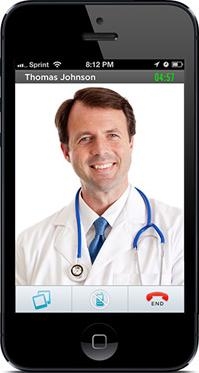Commentary
Doctor On Demand Brings Docs Into The App...Literally
- by Steve Smith , Staff Writer @popeyesm, December 11, 2013
 On
some surface level, the idea of putting video chat doctor appointments into a mobile app seems like taking device technology just a step too far. Our tendency is to associate the latest gadgetry with
excessive automation that further erodes human contact. Well -- if you have been to a doctor lately you realize that that cow left the barn years ago. In the last year I have had to deal with the
health care system and was shocked to discover how much face time with a physician was actually spent watching them stare at a computer screen and type. The Doctor On Demand app now available for iOS and Android makes perfect sense to me. In this app, which connects patients to a doc anytime anywhere via video,
the doctor actually has to look at you.
On
some surface level, the idea of putting video chat doctor appointments into a mobile app seems like taking device technology just a step too far. Our tendency is to associate the latest gadgetry with
excessive automation that further erodes human contact. Well -- if you have been to a doctor lately you realize that that cow left the barn years ago. In the last year I have had to deal with the
health care system and was shocked to discover how much face time with a physician was actually spent watching them stare at a computer screen and type. The Doctor On Demand app now available for iOS and Android makes perfect sense to me. In this app, which connects patients to a doc anytime anywhere via video,
the doctor actually has to look at you.
The app can be used in 15 states at launch, according to the announcement, and it already has a team of 1,000 physicians nationally. The app allows you to enter your symptoms or concern, pay $40, and get connected via video to a doctor. The app does not pretend to be right for all instances -- especially emergencies. But it does recommend itself as an option for non-critical concerns like colds and flu, pediatric worries, rashes and eye problems, prescription refill problems and general health questions. In other words, it is addressing the common sets of health worries that send millions of people online everyday seeking health information and diagnosis through chat groups.
Doctor On Demand has seed funding from Google Ventures, Andreessen Horowitz and Venrock, as well as advisory support from former U.S. Senator and health policy wonk Tom Daschle, who is on the board.
PWC predicts that spending on mHealth monitoring and applications will hit $23 billion by 2017. They expect that the impact on health care will be profound, even if the various constituencies and pieces of this massively complex system have not figured out how to make use of them. Expect to see more.
Doctor On Demand makes interesting use of the basic mobile technologies like picture-taking. It suggests that patients have the ability to upload images of rashes, burns, and other demonstrable symptoms and causes of worry for the doc to evaluate on the spot. The video camera itself certainly could be used to show a pediatrician the child in distress, which is better than a verbal description. I am not sure anyone will be opening wide and saying “ahhh” to the vid cam.
At the very least, mobile entrepreneurs have open to them a populace that is forever looking for answers and reassurance. Much of the mHealth investment likely will be going to B2B ideas for medical monitoring. But the field is wide open to address consumer frustration and worry. I can’t attest to how well DoD works, or even how advisable it is in a range of circumstances. It seems to offer by app some of the consumer-friendly interfaces with healthcare that built these networks of medi-quick shops that replace ERs. And for good reason. I have to say, in dealing with the healthcare system for me, my daughter and wife in recent years, these ER alternatives have given us more personable and holistic care than the layers of specialists and world-class medical schools and clinics we have also encountered. In fact, as one goes up the ladder to ever more specialized and prestigious doctors, it has been my experience that the treatment becomes more impersonal and technology dependent.
At the very least, this app may achieve what seems impossible today in most clinical settings. When the doctor is looking at a computer screen, now he is actually looking at her patient.



